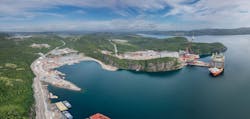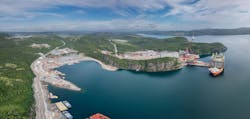Sarah Parker Musarra
Editor
Claimed by owner Nalcor Energy to be Atlantic Canada’s largest industrial fabrication site, Bull Arm fabrication yard has been involved in some of the area’s biggest and most notable offshore assets. Bull Arm is on a protected port off St. John’s, with unfettered, deepwater access to the Atlantic, and sprawls out over 6,300 acres (9,308 H), with more than 23,000 sq m (247,570 sq ft) of enclosed facilities and more than 500 m (1,641 ft) of wharfage.
The yard was originally established for the gravity-based structure (GBS) of ExxonMobil’s Hibernia project, located off Newfoundland and Labrador, Nalcor Energy Vice President of Business Development Chris Kieley toldOffshore at May’s Offshore Technology Conference. That GBS is said to be Canada’s largest offshore platform.
Bull Arm has three key theaters: the marine facility, fabrication yard, and deepwater site, which is where the Hebron platform is sitting as it awaits its eventual tow-out. Kieley said at OTC that this was expected to occur within that same month. In addition to the main project areas, it has ancillary facilities. Bull Arm allows for steel fabrication, concrete construction, integration, and commissioning. Supply servicing, and major industrial fabrication and manufacturing can also be performed.
The marine facility’s total area of 140,000 sq m (1,506,947 sq ft) includes a dry dock, which was used to build the Hebron and Hibernia platforms, as well as five quays and warehouses to support platform construction. It also has a fabrication building, several multi-purpose industrial buildings and a laydown area. The deepwater site, which provides access to international shipping lanes, has a ferry terminal and a laydown area, along with power supply, telecommunications facilities, and water connections. Nalcor says that the marine facility has previously been used for port activities and could be used for logistic purposes in the future.
The fab yard has a module hall with two 75-metric ton (83-ton) cranes; a receiving quay; a cutting shop and assembly hall; a pipe shop; and other facilities. In total, its 120,000 sq m fabrication site is supported by 20,600 sq m of enclosed fabrication and support facilities and marine infrastructure to support the fabrication, assembly and load-out of modular components.
Kieley said that multi-million dollar upgrades were recently performed to the Bull Arm facilities and roads during the Hebron project.
The entire yard has been leased to ExxonMobil during the Hebron project. As the structure moves on to its destination offshore St. John’s, Kieley said the site has put out expressions of interest as it looks for its next opportunity.
Bull Arm has played a significant role in developing the province’s burgeoning offshore oil and gas industry, having been involved in multiple mega projects off its coastlines.




